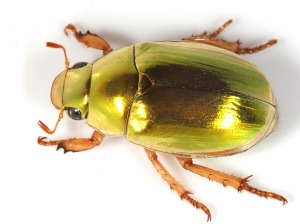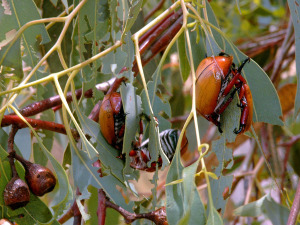Garden activities for kids, Minibeast of the moment, Our environment
Where have all the Christmas Beetles Gone?

In this blog, we share some interesting Christmas Beetle facts and provide 5 Christmas Beetle Challenges for Kids.
Did you know, that in the 1920s, Christmas beetles were reported to be drowning in huge numbers in Sydney Harbour…. tree branches were seen to be bending into the water under the sheer weight of the massed beetles!
It’s unlikely that you’ll find such a huge number these days (especially if you live in the city) but the kids will be delighted to find them clustered around your outdoor lighting. These nocturnal creatures are members of the scarab family. They are noisy, clumsy fliers that are most active around sunset and the hours immediately after.
By the time you’ve spotted a Christmas beetle, it’s actually at the end of its lifecycle! It’s already spent at least a year underground as a ‘C’ shaped white larvae (sometimes called a curl-grub) munching away on underground roots and decaying vegetation. In some parts of the country, the larvae may have spent 2 years underground, waiting for the right conditions and temperature. Towards the end of winter, most larvae move closer to the soil surface, pupate, and then push through the surface of the soil to emerge as an adult Christmas beetle.
Some of these beetle species are now in decline due to loss of habitat, and in some areas there are now several introduced species that are ‘imposters’. This can make identifying your beetle tricky, so make sure you use a local identification book or guide to find out what species is munching on the trees at your place.

5 CHRISTMAS BEETLE CHALLENGES FOR KIDS
1) Using a magnifying glass, how many of these features can you see?
• 2 clubbed antennae
• 6 spiky legs tipped with claws
• Front legs of uneven lengths (scientists think this helps them to get a better grip on thin eucalyptus leaves)
• 2 hard elytra (protective wing cases that are found on the top of the beetle)
2) Create a beetle inspired artwork! What colour is your beetle?
Your child might like to create an artwork of their beetle after closely studying the colours. Christmas beetles can be found in a variety of different colours depending on the species. Most commonly found are: pale to dark brown, green, and a beautiful yellowy-green iridescent colour. In some parts of Queensland, the colours found can include gold, violet, magenta, blue and even iridescent opal! You can find some stunning pictures of these rarer colours here: http://bunyipco.blogspot.com.au/2011/12/tis-season.html
3) How big is your beetle?
Place your beetle gently on a ruler. Is your beetle bigger or smaller than the average size of 20-30mm?
4) Christmas beetle clues! How many of these clues that Christmas beetles are around can you find in your garden?
• Withered, dead or yellow patches of grass (the larvae of Christmas beetles love feeding on underground plant roots of grasses, crops, lawns and pasture)
• ‘Defoliated’ eucalyptus trees
• Eucalyptus leaves with zigzag cuts parallel to the main leaf vein. Christmas beetles are wasteful eaters – lots of leaf materials falls to the ground during their munching process!
• Loud whirring noises
• Dead Christmas beetles scattered around near outdoor lighting sources
5) Make a beetle habitat in jar
• Find a large aerated container or box
• Place a jar of water inside your container that’s filled with small branches of fresh gum leaves (try and use the eucalyptus leaves that your beetle was found near)
• Spray your beetle with clean water once a day, and make sure the gum leaves stay fresh and non-wilted
• After you’ve enjoyed watching and learning about your beetle for a day or two, bid your beetle farewell and release it back to the wild to complete its life cycle!
We hope Christmas Beetles visit your little green thumbs this year
Happy gardening
Erica

